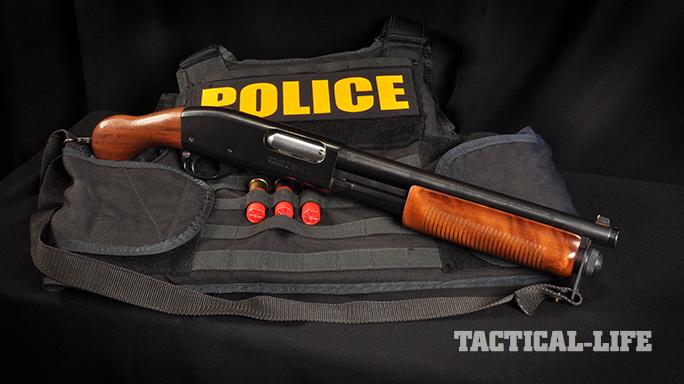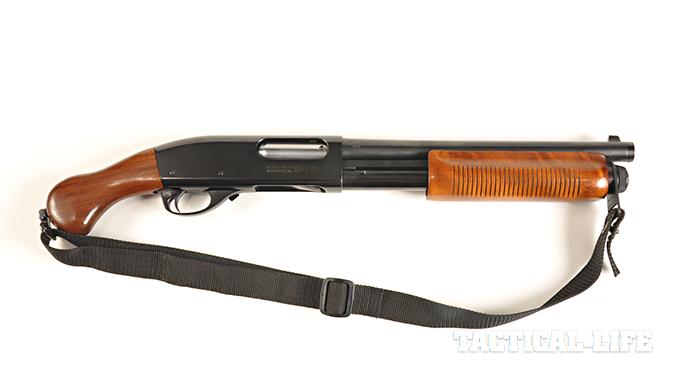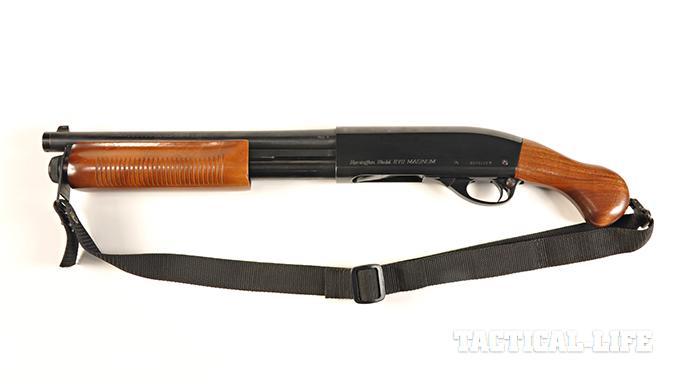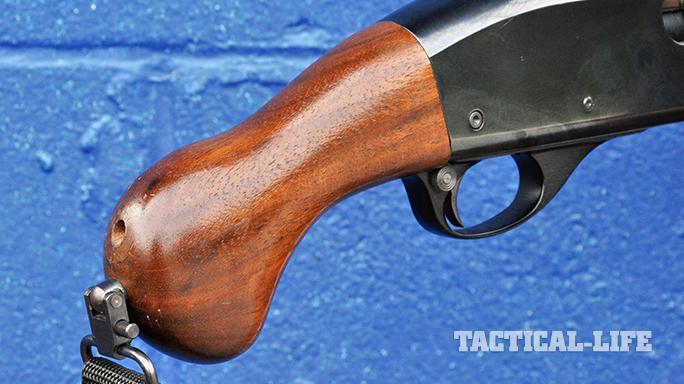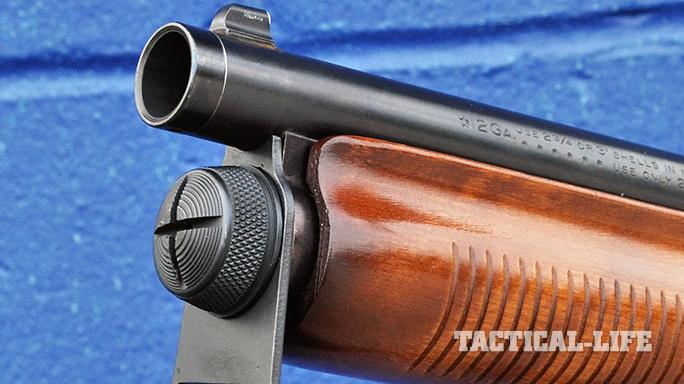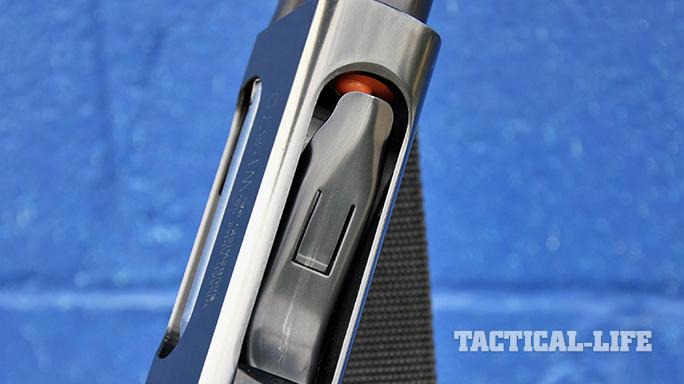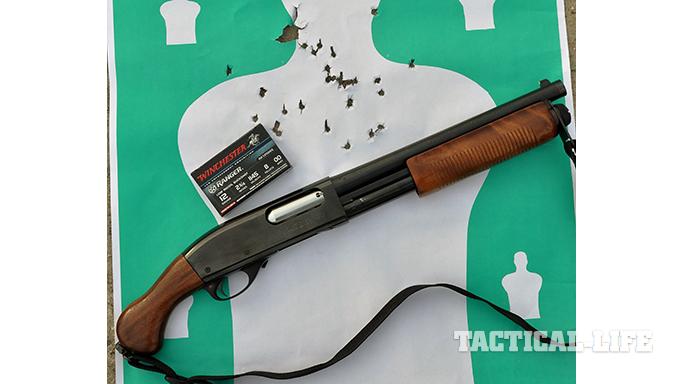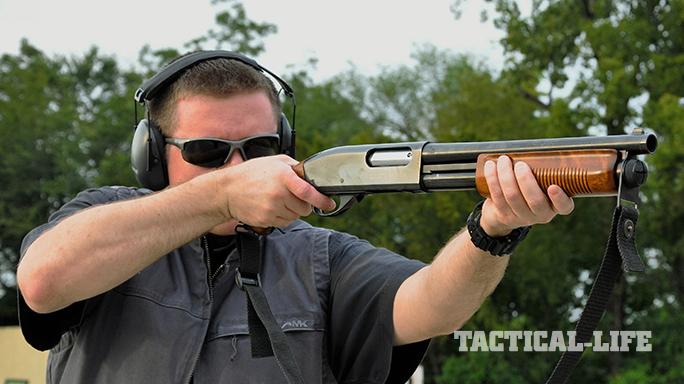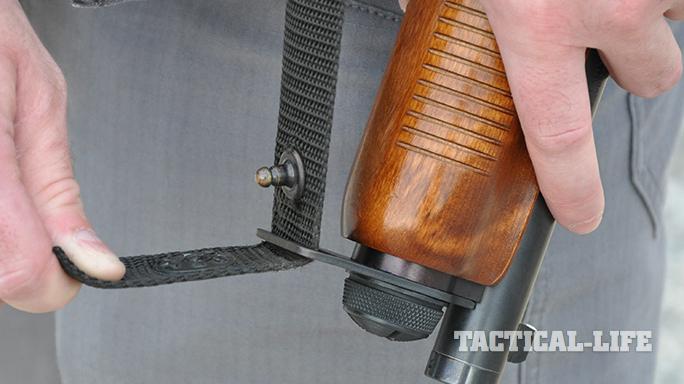The shotgun is, by far, the longest-serving long gun in the American law enforcement community. It served Doc Holliday and Wyatt Earp well and, in 2017, continues to be the most prevalent long gun in the armories of police agencies across the country. While most law enforcement shotguns are bland and unexciting, there are specific versions that hold a unique appeal. One of those is the Witness Protection 870, or WP870.
The WP870 gains its name from its adoption and use by the United States Marshals Service. Fellow gun scribe Chris McLoughlin outlined the beginnings of the original guns in a 1984 article. According to McLoughlin, Gene Thompson, Lynn Jordall and Jim Wilson built three prototypes. This was a collaborative effort with each man working on a select feature to produce the most effective platform. The result was a cut-down Remington 870 with a 14.5-inch barrel, a custom-built hand stop and, most significantly, an ergonomic grip that retained the shape of the original factory stock. Other modifications included a slotted shell lifter to assist in clearing a short-stroke-induced double feed and a unique sling system. In the 1984 article, McLoughlin reports that some 240 modified 870s were in the inventories of the Marshals Service.
Marshal’s Scatterguns

The WP870 has made several appearances in the media. I have a clipping from the November 11, 1985, issue of Newsweek magazine in my files that carried the headline “Busting the Bhagwam.” A photo shows a U.S. marshal carrying a WP870 as he escorts a prisoner to a hearing in Charlotte, North Carolina. In an Associated Press photo from February 2, 1987, a female marshal is shown providing court security during the trial of narco trafficker Carlos Lehder Rivas. The sight of this sawed-off scattergun certainly attracted attention and served as a deterrent.
Advertisement — Continue Reading Below
- RELATED STORY: Remington Debuts the Model 870 Tac-14: No Tax Stamp Required
Jim Wilson was a talented machinist whose modest shop was located on Oriole Street in Brunswick, Georgia. Wilson saw the potential for other government, law enforcement and civilian sales of the WP870. Wilson provided two distinct services regarding the WP870. The first was a conversion of an agency shotgun. The second was to convert a customer’s personal 870 into a WP870. In 1984, the conversion cost was listed as $214.80. Because this was a conversion of a non-NFA shotgun, the BATFE classified it a short-barreled shotgun (SBS), which mandated a $200 tax stamp for individuals. Later, Wilson became a Remington manufacturer and received receivers and parts to build 50 guns. Since these were manufactured in the WP870 configuration, the BATFE classified these guns as Any Other Weapons, or AOWs, making them subject to a $5 AOW tax stamp. Unfortunately, the arrangement between Wilson and Remington did not continue, and no more WP870s were manufactured as AOWs.
The barrels on the original marshals guns were simply cut to 14.5 inches with little thought or testing given to patterns and performance. Wilson made several changes to the original WP870 design, with the most notable changes being to the barrel. Wilson thought the 14.5-inch barrel was longer than needed and cut the barrel to 12.5 inches, just even with the magazine cap. Wilson wanted to improve the performance of his gun and installed a modified WinChoke to tighten up the patterning. The barrel retained a factory bead sight. As with the original design, the grip is manufactured from the original stock and is rounded to a bird’s head configuration. As with any combat shotgun, the shotgun was given a shorter forend to allow access to the loading port while the slide is in the rearward position.
One of the marshals’ requirements of the Witness Protection 870 was that it be concealable under a jacket. The original designers came up with an ingenious solution to carry the 25-inch shotgun. The hand stop, which was installed at the end of the magazine tube to prevent the user’s hand from slipping in front of the muzzle, also served as a sling receptacle. A traditional sling swivel was installed at the rear of the pistol grip. The key to this system was the design of the sling. The designers utilized an M1 Carbine sling with a quick-release snap that was mounted to the hand stop. The shotgun could be slung under a jacket in an upside-down configuration. To present the shotgun, the user would grasp the forend with his or her support hand, reach across their body and unsnap the sling. This freed the shotgun, and the support hand pulled the gun from under the jacket for a reasonably efficient presentation.
Advertisement — Continue Reading Below
Witness Protection 870 Range Test

We were fortunate to have access to one of the Wilson Arms Witness Protection 870 for this evaluation. Our test gun retained the original blue finish and was equipped with a wooden forend and reshaped grip. The owner had previously installed a “Flex-Tab” kit to update the shell lifter and replaced the standard bead sight with an XS tritium bead. While purchased in 1997, the WP870 was in pristine condition.
To be effective, the WP870 requires a unique firing position. The preferred position is to bring the shotgun to eye level and extended away from the face. In this manner, the WP870 is capable of sighted fire as if it were a stocked shotgun. To maximize recoil control, a push/pull grip is used with the support hand pushing forward while the strong hand pulls to the rear. Invariably, a new shooter will want to shoot it from the hip, Hollywood style. However, they will quickly learn how easy it is to miss an entire target from as close as 10 yards.
We tested the WP870 with three Winchester loads. The first was the Super-X #4 buckshot load, which is comparable to the round issued by the U.S. Marshals Service. Winchester also has two low-recoil 00 buckshot loads in its Ranger line. We tested both eight- and nine-pellet reduced-recoil loads. We also tested the nine-pellet Ranger frangible 00 load. This load is designed for CQB, training and special applications.
Advertisement — Continue Reading Below
Given the mission parameters of the Witness Protection 870, we conducted pattern testing at 15 yards. The #4 buckshot, which is a sporting and hunting load, produced a pattern that measured 24 by 21 inches, with the diameter being 31.8 inches. The reduced-recoil Ranger loads patterned significantly better, with the nine-pellet load producing a pattern of 7 by 9 inches (11.9-inch diameter) while the eight-pellet pattern measured 7.5 by 9.5 inches (12.1-inch diameter). The nine-pellet frangible load created a 10-by-12.5-inch pattern with a 16-inch diameter. Our shooting impressions were very positive when the proper technique was utilized. The #4 load produced the sharpest recoil, while both reduced-recoil loads were quite easy to shoot.
In the age of compact rifle-caliber carbines and, to a lesser extent, submachine guns, many view the shotgun as an antique whose time has passed. However, anyone who has racked an 870 on a suspect at 2:00 a.m. can attest to how abruptly the suspect will change their attitude. The WP870 was designed for a specific close-protection role, and it protected lawmen and bad guys equally. It has a very quiet but notable history that will not be forgotten by those who relied on it.
The Witness Protection 870 has also been featured in movies—including Eraser, Enemy of the State and The Book of Eli—and on television, in shows like Justified. For those who wish to own a piece of history, versions of the WP870 design have been copied by other manufacturers and can still be located in NFA circles.
Advertisement — Continue Reading Below
